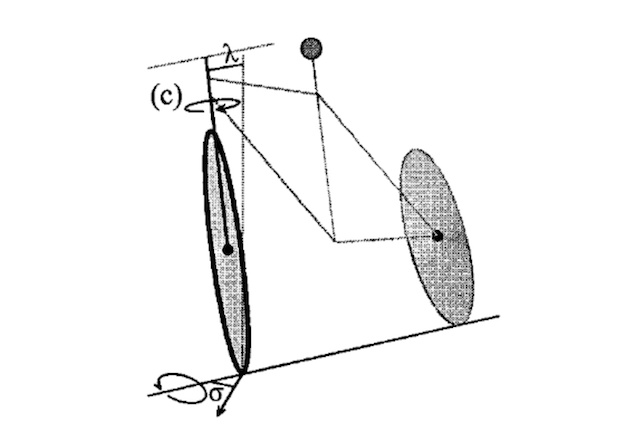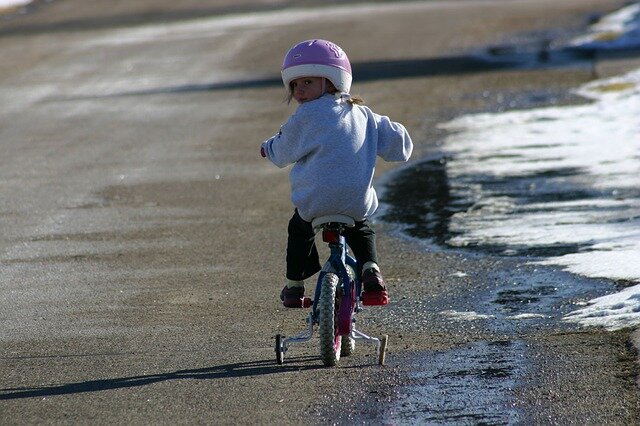What does counter-steering mean during bicycling riding?
Countersteering is defined as the act of steering in the opposite direction to initiate a turn. The word counter-steering is a mashup of counter and steering where counter means against and steer means to guide or direct.
The rider can steer to the left by first briefly torquing the handlebars to the right, allowing the bike to fall into a leftward lean.
How to counter-steer on your bike
Countersteering is NOT actually turning your wheel the opposite direction of your intended turn, but instead, you lean or push the handlebar forward into the intended direction of the turn.
Counter-steering uses centrifugal forces and the geometry of your bike to lean you into a corner or a turn.
Counter-steering as a mathematical equation (Image Source: American Journal of Physics)
Here is how to counter-steer into a right turn/corner:
Turn your wheel slightly to the left - for a tiny instant the bike will steer left
The bike will almost instantly lean right. As this happens you will begin turning right
The bike will hold this right-lean without any effort from you.
This is summed up by the saying press right, lean right, go right.
just “lean” into the turn
Most motorcycle riders and cyclists know that once up to road/trail speed if you want to turn left you to push on the left handlebar and pull on the right grip, this is known as countersteering.
As the rider pushes forward on the left grip and pulls back on the right, the front-wheel turns slightly to the right, which forces the rider’s center of mass to the left on the bike. The centrifugal action then initiates a leftward lean and turn, which is further magnified by gravity.
Almost all riders, cyclist, gravel grinders, and mountain bikers subconsciously initiate most of their turns by counter-steering, but usually describe it, by saying, “just lean into the turn.”
William Rankine & bicycle balance
William Rankine, a Scottish engineer, was the first to describe the phenomenon of countersteering in 1869, during a time period when bicycles were more commonly known as velocipedes.
In 1897, Emmanuel Carvallo and Francis Whipple developed Rankine’s theory further, using the safety bicycle, which has very similar geometry of modern-day bicycles.
Safety bicycle (late 1880s)
gyroscopic effects & bicycle stability
“The role of gyroscopic effects in bicycle stability is often misunderstood and overstated.”
Many researchers have shown that the gyroscopic torque accounts minimally to bicycle stability since the front wheel is light, relative to the rest of the bike and rider, which results in a minimal gyroscopic effect. Bicycles are more stable and easier to ride at higher speeds, but this is not from an increase in gyroscopic torque.
factors that affect counter-steering
There are 6 factors that affect counter-steering:
Turn Radius
Speed
Gravity
Time to initiate the turn
Coefficient of friction
Outside forces - Such as wind
A smaller turn radius and a higher speed require more counter-steering as the rider will have to lean even more for a smooth and steady turn.
no counter-steering & training wheels
Training wheels offer stability but change the dynamics of steering. The counter-steering effect is lost since the training wheels prevent the bicycle from leaning.
However, kids will naturally counter-steer once the training wheels have been removed, as counter-steering a bicycle is intuitive.
counter-steering & unicycle
For traditional two-wheel bicycles, countersteering is only for turning left and right. However, a unicyclist can fall left, right, forward and backward, adding many more layers of complexities.
Jesse is Director of Pedal Chile and lives in Chile’s Patagonia….most of the year. Jesse has a Master of Science in Health & Human Performance and is an avid mountain biker. Hobbies: Riding the active volcano in Pucón, reading & writing non-fiction, craft beer, and attempting to crush life.
Sources:
Fajans, J., 2000. Steering in bicycles and motorcycles. American Journal of Physics, 68(7), pp.654-659.
Galli, J. Ronald, and Bradley W. Carroll. “The Four-Ball Gyro and Motorcycle Countersteering.” The Physics Teacher, vol. 55, no. 4, Apr. 2017, pp. 238–239, 10.1119/1.4978726.
Lopes, B. and McCormack, L., 2017. Mastering Mountain Bike Skills. Champaign, IL: Human Kinetics.
Prince, PJ, and Ahmed Al-Jumaily. “Bicycle Steering and Roll Responses.” Proceedings of the Institution of Mechanical Engineers, Part K: Journal of Multi-Body Dynamics, vol. 226, no. 2, 7 Mar. 2012, pp. 95–107, 10.1177/1464419312440642.
















